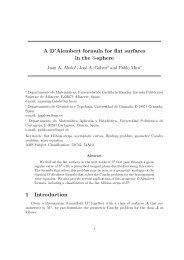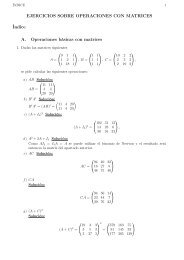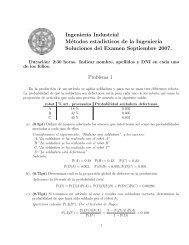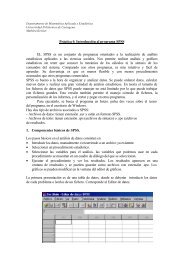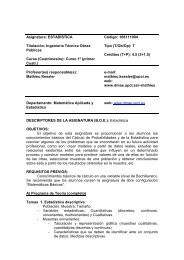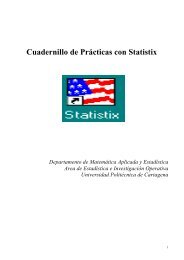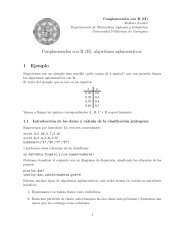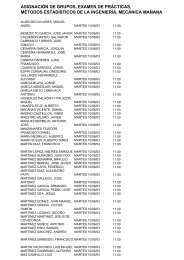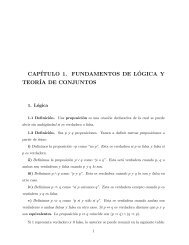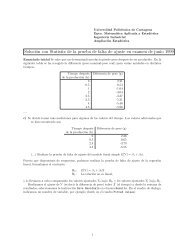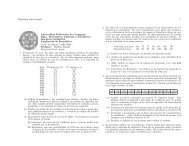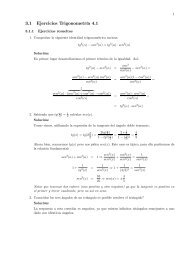Transformada de Laplace y sus aplicaciones a las ecuaciones ...
Transformada de Laplace y sus aplicaciones a las ecuaciones ...
Transformada de Laplace y sus aplicaciones a las ecuaciones ...
Create successful ePaper yourself
Turn your PDF publications into a flip-book with our unique Google optimized e-Paper software.
<strong>Transformada</strong> <strong>de</strong> <strong>Laplace</strong><br />
= lim<br />
x→+∞<br />
Z<br />
γ1 ∙Z x<br />
0<br />
e (ω−z)t ¸<br />
F (ω)dt dω,<br />
aplicando el Teorema <strong>de</strong> Fubini. Por integración directa<br />
Z<br />
¡ ¢ (ω−z)x F (ω)<br />
2πiL[f](z) = lim e − 1<br />
x→+∞<br />
ω − z dω.<br />
γ 1<br />
Para z fijo en el semiplano Re z > α, eltérminoe (ω−z)x converge uniformemente a 0 si<br />
x → +∞ y el integrando converge a −F (ω)/(ω − z) en γ1.Así Z<br />
Z<br />
Z<br />
F (ω) F (ω) F (ω)<br />
2πiL[f](z) = − dω = dω −<br />
γ ω − z 1<br />
γ ω − z 2<br />
Γ ω − z dω<br />
Z<br />
F (ω)<br />
= 2πiF (z) −<br />
ω − z dω.<br />
Γ<br />
Por otra parte, sea τ(t) =ρeit , t ∈ [0, 2π] una circunferencia <strong>de</strong> radio ρ >Ryconteniendo<br />
a Γ. Entonces Z<br />
Z<br />
F (ω)<br />
dω =<br />
Γ ω − z τ<br />
F (ω)<br />
ω − z dω,<br />
<strong>de</strong> don<strong>de</strong> ¯Z ¯¯¯<br />
τ<br />
F (ω)<br />
ω − z dω<br />
¯ ≤<br />
M<br />
|ρ| β 2πρ → 0 si ρ → +∞.<br />
(ρ − R)<br />
Así Z<br />
F (ω)<br />
dω =0<br />
Γ ω − z<br />
ycomoαera arbitrario, la fórmula L[f](z) =F (z) es válida para todo Re z>σ.<br />
Remarquemos aquí que la condición (1.13) <strong>de</strong>l resultado anterior se cumple para funciones<br />
<strong>de</strong> la forma F (z) =P (z)/Q(z) don<strong>de</strong> P y Q son polinomios tales que <strong>de</strong>g Q ≥ 1+<strong>de</strong>gP ,<br />
don<strong>de</strong> <strong>de</strong>g P <strong>de</strong>nota el grado <strong>de</strong> P . Así por ejemplo, la <strong>Transformada</strong> inversa <strong>de</strong> la función<br />
F (z) = z<br />
z2 +1<br />
pue<strong>de</strong> calcularse como<br />
L −1 [F ](t) = f(t)<br />
= Res(e tz F (z),i)+Res(e tz F (z), −i)<br />
it i<br />
= e<br />
2i + e−it i<br />
−2i =cost.<br />
22



